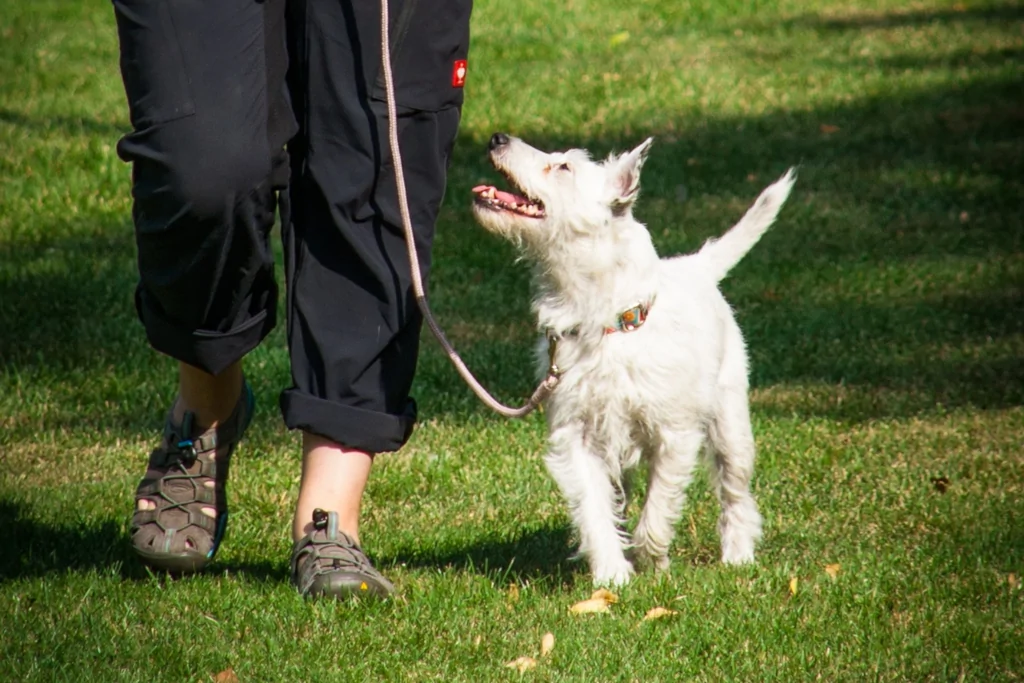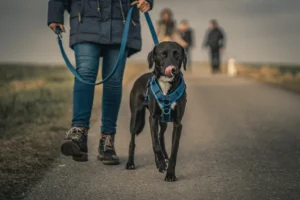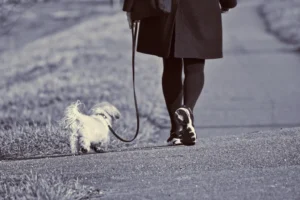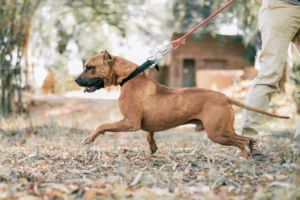Imagine taking a leisurely stroll with your canine friend, both of you enjoying the sights and sounds without the constant struggle of your dog tugging and pulling on the leash.
Picture the perfect walk, where your dog is by your side, calmly and attentively following your lead. Heeling is the key to achieving this ideal walking experience, and in this blog post, we’ll show you how to make it a reality.
From understanding the importance of heeling to overcoming common challenges, this guide will equip you with the tools you need to transform your walks together.
You might be surprised by the positive impact that mastering heeling can have on your bond with your four-legged friend!

Why is Heeling Important?
Heeling is an essential skill for your dog to develop because it leads to a more enjoyable and safer walking experience for both of you.
Proper heeling reduces the risk of accidents, like your dog darting after a squirrel and pulling you off balance. It also helps prevent your dog from jumping on people or getting into unwanted confrontations with other animals.
Furthermore, heeling can be a stepping stone to teaching your dog other valuable commands and building a stronger bond between the two of you. Just like in human relationships, consistent communication forms the backbone of trust; when your dog heels on command, it demonstrates a clear line of mutual understanding.
Benefits of a Well-trained Heeler
A well-trained heeler can make your walks together more enjoyable, but the benefits don’t end there. By mastering heeling, your dog will also:
- Develop better self-control, leading to improved behavior in various situations.
- Gain increased mental stimulation from focusing on you during walks, which can help reduce boredom and related behavior issues.
- Strengthen trust and communication between you and your dog, fostering a deeper bond.
- Enhance your dog’s overall quality of life, as a well-trained dog is often more welcome in public spaces and social situations.
With these benefits in mind, let’s dive into the process of teaching your dog how to heel effectively.
How to Teach Your Dog to Heel?
To teach your dog how to heel, follow these step-by-step instructions:
- Choose a cue word. Before you begin, decide on a cue word for the heeling behavior, such as “heel” or “with me.” Consistency is key, so make sure to use the same word every time.
- Start in a low-distraction environment. Begin training in a quiet, familiar space where your dog can focus on you without being overwhelmed by external stimuli.
- Position your dog. Stand with your dog on your left side, with their shoulder aligned with your leg. If you prefer your dog on the right, simply adjust accordingly.
- Use treats or a toy as a lure. Hold a treat or your dog’s favorite toy in your left hand (or right if your dog is on the right side) near your thigh. This will encourage your dog to pay attention to your movements and maintain the desired position.
- Start walking. Say your cue word and take a few steps forward. If your dog stays in position, reward them with the treat or toy and praise them enthusiastically.
Tip: Interestingly, dogs often take cues from our body language more than our words. Keeping your posture relaxed yet confident can signal your dog that you’re in control, aiding in the training process.
By following these initial steps, you’ll lay a solid foundation for heeling with your dog. Once you’ve established the basics, it’s time to further advance their skills and enhance your walking experience together.
Advancing Your Dog’s Heeling Skills
Now that you’ve taught your dog the fundamentals of heeling, it’s time to enhance their skills and make the behavior more reliable in different situations. Follow these steps to refine your dog’s heeling abilities and ensure a calm and controlled walking experience:
- Practice and gradually increase the challenge. As your dog becomes more comfortable with the heeling behavior, slowly increase the distance you walk and gradually introduce more distractions. This will help your dog generalize the skill to various environments.
- Add turns and changes of pace. Once your dog has mastered the basic heel, incorporate turns and changes in walking speed to make the exercise more dynamic and engaging.
- Phase out the lure. Over time, gradually reduce the frequency of treats or toys as rewards, and rely more on verbal praise and physical affection. Eventually, your dog should respond to the cue word without the need for a lure.
- Introduce additional distractions and real-life scenarios. As your dog becomes more proficient in heeling, it’s important to expose them to a variety of situations, such as busy streets, parks, or encounters with other dogs. This will help your dog learn to maintain focus and heel effectively in different environments.
- Maintain consistency and practice regularly. Consistent practice is key to solidifying your dog’s heeling skills. Set aside time for regular training sessions, and try to incorporate heeling practice into your daily walks. This will help reinforce the behavior and make it a natural part of your dog’s routine.
With these added steps, your dog’s heeling skills will continue to improve, leading to a more enjoyable and controlled walking experience for both of you.
Remember, patience and consistency are crucial when teaching your dog to heel. Each dog learns at their own pace, so be prepared to invest time and effort into the training process.

Mastering Heeling with Positive Reinforcement
Positive reinforcement is essential in heeling training, as it fosters a strong bond, encourages good behavior, and makes the learning experience enjoyable for both you and your dog.
This training method rewards desired behaviors, increasing the likelihood of your dog repeating them in the future. To successfully incorporate positive reinforcement in your heeling training, consider the following guidelines.
First, remember that timing is crucial. Make sure to reward your dog immediately after they perform the desired behavior, such as maintaining the correct position while heeling. This helps your dog associate the reward with the specific action, reinforcing its repetition.
Next, make sure to use high-value rewards. Identify what motivates your dog the most, whether it’s treats, toys, or praise. Use these rewards during training to keep your dog engaged and excited to learn.
In addition, try to keep rewards unpredictable. Vary the type and frequency of rewards to maintain your dog’s interest and prevent them from becoming too reliant on receiving a treat for every correct behavior.
Whatever happens, try to celebrate small successes. Recognize and reward your dog’s progress, even if it’s just a small improvement. This encourages your dog to continue working towards mastering the heeling behavior.
Finally, stay patient and positive. Remember that training takes time and every dog learns at their own pace. Keep a positive attitude, maintain patience, and celebrate the milestones you reach together.
By using positive reinforcement consistently and effectively, you’ll help your dog develop a strong heeling behavior and enhance your bond, resulting in a more enjoyable and controlled walking experience.
Suggested Blog Post: Training Tools for Leash Pullers
Overcoming Common Heel Training Challenges
Training your dog to heel can come with its own set of challenges, but with patience and persistence, you can overcome them. Some common issues dog owners face include:
Lack of focus. If your dog seems easily distracted, try training in a low-distraction environment and gradually introduce new distractions as your dog’s focus improves. You can also use higher-value treats or toys to capture their attention.
Pulling on the leash. To curb this behavior, stop walking immediately when your dog starts pulling. Wait for them to return to the correct position before resuming the walk. Over time, your dog will learn that pulling leads to an interruption in their walk. Additionally, check our guide on leash training.
Inconsistent positioning. If your dog struggles to maintain the correct position while heeling, try using a shorter leash or a training tool like a head halter or no-pull harness to provide better control and guidance.
Getting bored during training. Keep training sessions short and engaging to prevent boredom. Vary the exercises, and incorporate playtime or other fun activities to maintain your dog’s interest.
Resistance to phasing out treats. Gradually reduce the frequency of treats and replace them with praise or other forms of positive reinforcement. This will help your dog learn to respond to the cue word without expecting a treat every time. If you notice your dog hesitating to heel without a treat, occasional surprise rewards can reignite their interest.
By addressing these common challenges and adjusting your training methods as needed, you’ll set your dog up for success in mastering the heel command, leading to a more enjoyable and controlled walking experience.
Similar to the heeling command, the ‘Drop it’ Command is highly useful as well, and we’ve broken it down in easy steps in this guide. To learn more about Basic obedience, check our our other guides for dog owners.
Finally, here’s a great video for beginner on how to start teaching your dog to heel:
FAQs
How long does it take to teach a dog to heel?
The time it takes to teach a dog to heel varies depending on the dog’s age, breed, and individual learning pace, but it typically takes several weeks of consistent practice.
Can older dogs learn to heel effectively?
Yes, older dogs can learn to heel effectively, though they may require more time and patience compared to younger dogs, as they may have ingrained habits to overcome.
Should I use a specific type of leash for heeling training?
A standard 4-6 foot leash is ideal for heeling training, as it provides enough room for your dog to maintain the proper position without allowing too much slack for pulling.
How can I keep my dog focused during heeling exercises?
To keep your dog focused during heeling exercises, use high-value treats or toys to capture their attention, train in low-distraction environments initially, and gradually introduce new distractions as their focus improves.
Alex, a passionate animal lover, has experience in training and understanding animal behavior. As a proud pet parent to two dogs and three cats, he founded AnimalReport.net to share insights from animal experts and expand his knowledge of the animal kingdom.









